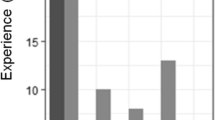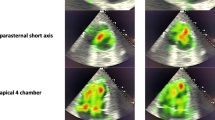Abstract
The aim was to gain insights into the visual behaviour and the perceptual skills of operators during catheter-based cardiovascular interventions (CBCVIs). A total of 33 CBCVIs were performed at the University Hospital Zurich by five operators, two experts and three novices, while wearing eye tracking glasses. The visual attention distribution on three areas of interest (AOIs) the “Echo screen”, “Fluoro screen” and “Patient” was analysed for the transseptal puncture procedure. Clear visual behaviour patterns were observable in all cases. There is a significant differences in visual attention distribution of the experts compared to the novices. Experts spent 79% of dwell time on the Echo screen and 17% on the Fluoro screen, novices spent 52% on the Echo screen and 40% on the Fluoro screen. Additionally, results showed that experts focused their gaze on smaller areas than novices during critical interventional actions. Operators seem to exhibit identifiable visual behaviour patterns for CBCVIs. These identifiable patterns were significantly different between the expert and the novice operators. This indicates that the visual behaviour of operators could be employed to assist transfer of experts’ perceptual skills to novices and to develop tools for objective performance assessment.




Similar content being viewed by others
References
BIS Research. Global minimally invasive surgical systems market: Detailed analysis and focus on robotic, endoscopic, and laparoscopic surgeries for 21 countries - analysis and forecast (2018–2025). 2018.
Singh, H. S., Osten, M., and Horlick, E., Future horizons for catheter-based interventions in adult congenital and structural heart disease. Future Cardiol. 8(2):203–213, 2012.
Lanzer, P., Textbook of catheter-based cardiovascular interventions. Cham: Springer International Publishing, 2018.
Krupinski EA. Textbook of catheter-based cardiovascular interventions. 2018.
Lanzer, P., Al-Naser, M., Bukhari, S. S., Dengel, A., and Krupinski, E. A., Eye tracking in catheter-based cardiovascular interventions: Early results. J Med Imaging. 4:035502, 2017.
Duchowski Theory AT. Eye tracking methodology. n.d.
Currie, J., Bond, R. R., McCullagh, P., Black, P., Finlay, D. D., Gallagher, S., Kearney, P., Peace, A., Stoyanov, D., Bicknell, C. D., Leslie, S., and Gallagher, A. G., Wearable technology-based metrics for predicting operator performance during cardiac catheterisation. Int J Comput Assist Radiol Surg. 14(4):645–657, 2019.
McLaughlin, L., Bond, R., Hughes, C., McConnell, J., and McFadden, S., Computing eye gaze metrics for the automatic assessment of radiographer performance during X-ray image interpretation. Int J Med Inform. 105:11–21, 2017.
Jacob R., Karn K. Eye tracking in human-computer interaction and usability Research: Ready to deliver the promises. 2003.
Mussgnug, M., Singer, D., Lohmeyer, Q., and Meboldt, M., Automated interpretation of eye–hand coordination in mobile eye tracking recordings. KI - Künstliche Intelligenz. 31:331–337, 2017.
Manning, D., Ethell, S., Donovan, T., and Crawford, T., How do radiologists do it? The influence of experience and training on searching for chest nodules. Radiography. 12:134–142, 2006.
Kundel, H. L., Nodine, C. F., Conant, E. F., and Weinstein, S. P., Holistic component of image perception in mammogram interpretation: Gaze-tracking study. Radiology. 242(2):396–402, 2007.
Acknowledgements
The authors would like to express their gratitude to all the participants of the study. Furthermore, we thank Alberto Pozzoli, Andrea Guidotti and Yves Haag for their contribution in planning the study and for their help in the data acquisition.
Funding
The authors have no funding to declare.
Author information
Authors and Affiliations
Corresponding author
Ethics declarations
Conflict of Interest
The authors declare that they have no conflict of interest.
Ethical Approval
All procedures performed in studies involving human participants were in accordance with the ethical standards of the institutional and/or national research committee and with the 1964 Helsinki declaration and its later amendments or comparable ethical standards.
Informed Consent
Informed consent was obtained from all individual participants included in the study.
Additional information
Publisher’s Note
Springer Nature remains neutral with regard to jurisdictional claims in published maps and institutional affiliations.
This article is part of the Topical Collection on Education & Training
Electronic supplementary material
ESM 1
(DOCX 16 kb)
Rights and permissions
About this article
Cite this article
Zimmermann, J.M., Vicentini, L., Lohmeyer, Q. et al. Visual Behaviour Strategies of Operators during Catheter-Based Cardiovascular Interventions. J Med Syst 44, 12 (2020). https://doi.org/10.1007/s10916-019-1480-5
Received:
Accepted:
Published:
DOI: https://doi.org/10.1007/s10916-019-1480-5




